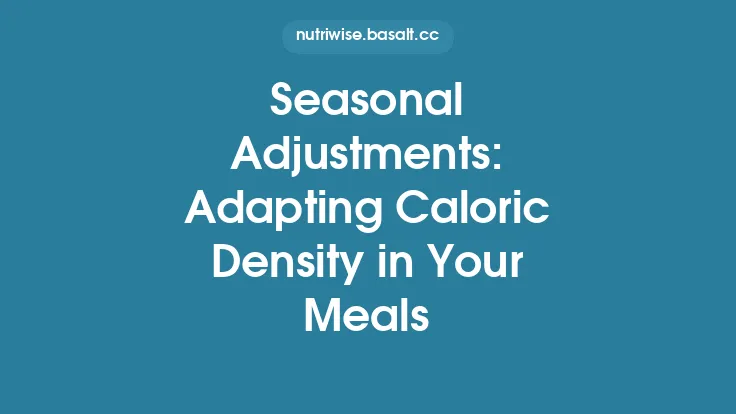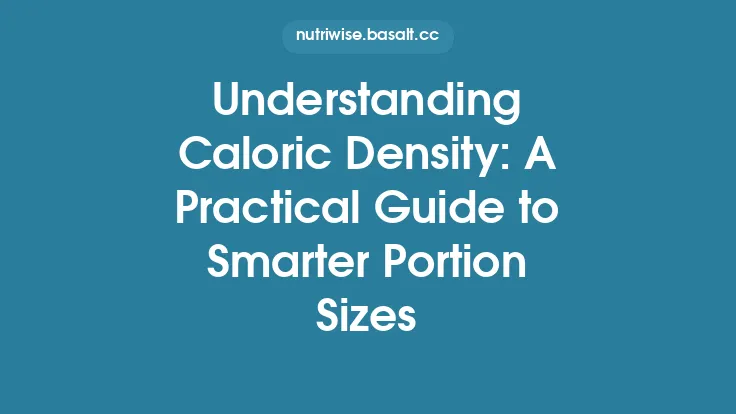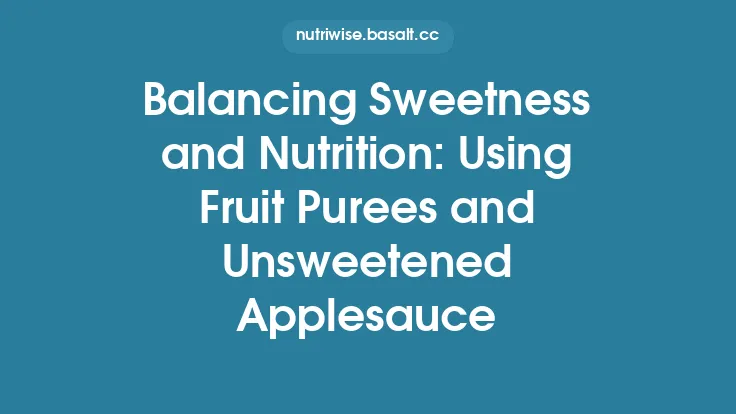Balancing meals is more than just counting calories or hitting a protein target; it’s about understanding how the energy packed into each bite—its caloric density—interacts with the macronutrient profile of the dish to create a harmonious whole. When you view meals through the lens of caloric density, you gain a powerful tool for shaping nutrient timing, optimizing performance, and sustaining long‑term health without relying on rigid portion‑size rules or exhaustive label reading. Below is a comprehensive guide that walks you through the science, the calculations, and the practical steps needed to craft balanced meals that respect both caloric density and macronutrient goals.
Why Caloric Density Matters for Meal Balance
Caloric density (kilocalories per gram, kcal·g⁻¹) tells you how much energy a food contributes relative to its mass. Foods with high caloric density (e.g., nuts, oils, dried fruit) deliver many calories in a small volume, while low‑density foods (e.g., leafy greens, broth‑based soups) provide few calories per gram.
When constructing a balanced meal, caloric density influences three critical aspects:
- Macronutrient Distribution – Because protein and carbohydrate each provide ~4 kcal g⁻¹ and fat provides ~9 kcal g⁻¹, the same gram weight of a high‑fat ingredient will dramatically shift the overall calorie‑to‑macro ratio compared with a high‑carb or high‑protein ingredient.
- Energy Balance Across the Day – By strategically placing higher‑density items in meals where you need a rapid energy boost (e.g., pre‑workout) and lower‑density items where satiety is paramount (e.g., dinner), you can smooth fluctuations in blood glucose and avoid mid‑day energy crashes.
- Nutrient Density Alignment – Caloric density can be decoupled from nutrient density (vitamins, minerals, phytonutrients). Understanding both lets you avoid “empty‑calorie” overload while still meeting macro targets.
Integrating Caloric Density with Macronutrient Targets
To blend caloric density insight with macro goals, follow a two‑step calculation:
- Define Your Macro Targets
- Example: 2,500 kcal/day with a 40 % carb / 30 % protein / 30 % fat split.
- Convert to gram targets:
- Carbs: 0.40 × 2,500 kcal ÷ 4 kcal g⁻¹ ≈ 250 g
- Protein: 0.30 × 2,500 kcal ÷ 4 kcal g⁻¹ ≈ 188 g
- Fat: 0.30 × 2,500 kcal ÷ 9 kcal g⁻¹ ≈ 83 g
- Map Food Items to Caloric Density and Macro Contributions
- Create a simple table (or spreadsheet) listing each food’s:
- Caloric density (kcal·g⁻¹)
- Macro breakdown (g per 100 g)
- Example entry:
| Food | kcal·g⁻¹ | Carbs (g/100 g) | Protein (g/100 g) | Fat (g/100 g) |
|---|---|---|---|---|
| Quinoa (cooked) | 1.2 | 21 | 4 | 2 |
| Almonds | 5.8 | 22 | 21 | 49 |
| Chicken breast (cooked) | 1.6 | 0 | 31 | 3 |
- Allocate Foods to Meals Using a “Density‑Weighted Macro Ratio”
- For each meal, decide the desired macro ratio (e.g., breakfast 45 % carb, 30 % protein, 25 % fat).
- Choose a mix of low‑density (vegetables, broth) and moderate‑density (whole grains, legumes) foods to meet the carb portion, and sprinkle in higher‑density protein/fat sources (lean meats, dairy, nuts) to hit the protein/fat targets without overshooting calories.
Practical tip: Use the formula
\[
\text{Meal kcal} = \sum_{i=1}^{n} (\text{mass}_i \times \text{kcal·g}^{-1}_i)
\]
and
\[
\text{Macro}j = \sum{i=1}^{n} (\text{mass}_i \times \text{macro}_j^{\%}_i)
\]
where *i indexes foods and j* indexes each macro. Solving these simultaneous equations (even with a simple spreadsheet solver) yields the exact gram amounts needed to hit both caloric density and macro goals.
Designing Balanced Meals Across the Day
1. Breakfast – “Fuel‑First”
- Goal: Provide quick‑acting carbs for glycogen replenishment while keeping overall density moderate to avoid early‑day caloric overload.
- Strategy: Pair a low‑density carbohydrate (e.g., oatmeal, 0.7 kcal·g⁻¹) with a moderate‑density protein (Greek yogurt, 1.0 kcal·g⁻¹) and a small high‑density fat source (a tablespoon of chia seeds, 4.5 kcal·g⁻¹).
- Result: A breakfast that delivers ~400 kcal, with a macro split close to 45 % carb, 30 % protein, 25 % fat, and a caloric density around 1.2 kcal·g⁻¹—light enough to be comfortably digested yet nutrient‑rich.
2. Lunch – “Sustaining Mid‑Day”
- Goal: Maintain satiety through volume while meeting a higher protein requirement for muscle maintenance.
- Strategy: Build a plate with a base of low‑density vegetables (e.g., mixed greens, 0.2 kcal·g⁻¹), a moderate‑density whole grain (brown rice, 1.1 kcal·g⁻¹), and a high‑density protein (grilled salmon, 2.0 kcal·g⁻¹). Add a modest amount of healthy fat (avocado, 1.6 kcal·g⁻¹).
- Result: A 600‑kcal lunch with a caloric density of ~1.4 kcal·g⁻¹, macro ratio ~40 % carb, 35 % protein, 25 % fat. The bulk of low‑density veg ensures fullness without excess calories.
3. Dinner – “Evening Balance”
- Goal: Reduce overall caloric density to aid overnight metabolic efficiency while still delivering adequate protein for repair.
- Strategy: Emphasize low‑density foods (steamed broccoli, 0.3 kcal·g⁻¹; cauliflower mash, 0.5 kcal·g⁻¹) and a modest portion of a moderate‑density protein (tofu, 1.2 kcal·g⁻¹). Limit added fats to a drizzle of olive oil (5.9 kcal·g⁻¹) for flavor.
- Result: A 500‑kcal dinner with an overall density of ~0.9 kcal·g⁻¹, macro split ~30 % carb, 40 % protein, 30 % fat—light on calories but rich in micronutrients.
4. Snacks – “Targeted Density”
- Goal: Provide quick, portable energy without disrupting macro balance.
- Strategy: Choose a high‑density snack when you need a rapid calorie boost (e.g., a small handful of walnuts, 6.5 kcal·g⁻¹) or a low‑density snack for satiety (e.g., sliced cucumber with hummus, 1.2 kcal·g⁻¹).
Applying Caloric Density to Different Dietary Patterns
| Dietary Pattern | Typical Caloric‑Density Focus | Example Meal Construction |
|---|---|---|
| Mediterranean | Moderate density with emphasis on monounsaturated fats | Olive‑oil‑dressed salad (low‑density veg + moderate‑density oil) + grilled fish (high‑density protein) |
| Plant‑Based | Often lower overall density; protein sourced from legumes, nuts | Lentil stew (moderate density) + kale sauté (low density) + a side of quinoa (moderate density) |
| Ketogenic | High overall density due to fat emphasis | Avocado (high density) + bacon (very high density) + leafy greens (low density) to add volume |
| Athlete‑Focused | Variable density; pre‑workout meals lean higher density carbs, post‑workout meals higher density protein/fat | Sweet‑potato mash (moderate density carb) pre‑training; whey shake (high density protein) post‑training |
The key is to match the density profile of each component to the functional role of the meal within the pattern, rather than applying a one‑size‑fits‑all portion rule.
Adjusting Meal Balance for Specific Goals and Populations
- Weight‑Maintenance vs. Weight‑Loss
- Maintenance: Aim for a daily average caloric density that aligns with your total energy expenditure (TEE). A balanced mix of low‑, moderate‑, and high‑density foods keeps energy intake stable.
- Loss: Slightly lower the overall daily density (e.g., target 0.9–1.1 kcal·g⁻¹) by increasing the proportion of low‑density vegetables and reducing high‑density fats, while preserving protein density to protect lean mass.
- Older Adults
- Challenge: Reduced appetite and risk of sarcopenia.
- Solution: Increase the density of protein‑rich foods (e.g., cottage cheese, 1.2 kcal·g⁻¹) while maintaining a base of low‑density vegetables for fiber and micronutrients. This boosts total protein intake without requiring large volumes.
- Endurance Athletes
- Challenge: High carbohydrate demand with limited stomach capacity during long sessions.
- Solution: Use moderate‑density carbohydrate sources (e.g., rice noodles, 1.3 kcal·g⁻¹) that provide more calories per gram than low‑density veg but are easier to digest than high‑density fats. Pair with low‑density electrolytes (e.g., sports drinks) for fluid balance.
- Individuals with Metabolic Conditions (e.g., Type 2 Diabetes)
- Challenge: Need stable post‑prandial glucose.
- Solution: Prioritize low‑density, high‑fiber carbs (legumes, non‑starchy veg) and moderate‑density protein, while limiting high‑density simple sugars. The slower gastric emptying of low‑density foods helps blunt glucose spikes.
Practical Workflow for Meal Planning Using Caloric Density
- Create a Master Food List – Include at least 30–40 foods spanning the density spectrum. Record kcal·g⁻¹ and macro percentages.
- Set Daily Macro Targets – Based on your goals, calculate gram targets as shown earlier.
- Allocate Macro Targets to Meals – Decide what percentage of each macro will be consumed at breakfast, lunch, dinner, and snacks.
- Select Anchor Foods per Meal – Choose one low‑density, one moderate‑density, and one high‑density food that together can meet the macro split.
- Run a Quick Spreadsheet Solver – Input the gram amounts as variables; constrain the total calories and macro grams to match the targets. The solver will output the precise gram weights needed.
- Adjust for Palatability & Lifestyle – Tweak the solution by swapping foods of similar density if needed (e.g., replace quinoa with farro).
- Batch‑Cook & Portion – Cook the moderate‑density staples in bulk, pre‑portion high‑density proteins into containers, and keep low‑density veg ready to assemble.
Time‑saving tip: Once you have a “template” for each meal (e.g., “low‑density veg + moderate‑density grain + high‑density protein”), you can rotate specific foods weekly without re‑doing the math each time.
Common Pitfalls and How to Avoid Them
| Pitfall | Why It Happens | Fix |
|---|---|---|
| Relying on a single “density” number for the whole meal | Overlooks the fact that each macro contributes differently to total kcal·g⁻¹. | Break the meal into component foods, calculate each separately, then sum. |
| Over‑compensating with high‑density fats to meet calorie goals | Leads to macro imbalance (excess fat, insufficient carbs/protein). | Keep fat sources moderate; use protein‑dense high‑density foods (e.g., lean meat) to meet calories without skewing macros. |
| Neglecting micronutrient density | Focusing only on calories can produce nutrient‑poor meals. | Pair each high‑density item with a low‑density, micronutrient‑rich side (e.g., leafy greens). |
| Using “density” as a proxy for “healthiness” | Some high‑density foods (e.g., sugary desserts) are low in nutrients. | Evaluate foods on both caloric density *and* nutrient density; prioritize foods that score well on both. |
| Forgetting the impact of cooking methods | Roasting can increase density by reducing water content. | Account for post‑cooking weight; if a food’s water loss is significant, adjust its kcal·g⁻¹ accordingly. |
Future Directions and Research Outlook
The intersection of caloric density and meal balancing is an active research frontier. Emerging areas include:
- Dynamic Density Modeling: Using wearable sensors to estimate real‑time gastric emptying rates, allowing personalized adjustments to meal density throughout the day.
- Machine‑Learning Meal Optimizers: Algorithms that ingest an individual’s macro goals, food preferences, and density data to auto‑generate weekly meal plans with minimal manual input.
- Food‑Structure Engineering: Development of novel food matrices (e.g., aerated protein gels) that manipulate density without compromising nutrient content, offering new levers for dietitians.
Staying attuned to these advances will enable you to refine your balancing strategies as science evolves, ensuring that your meals remain both nutritionally sound and enjoyable.
By treating caloric density as a strategic variable rather than a static label, you gain the flexibility to design meals that meet precise macro targets, support specific performance or health goals, and adapt to diverse dietary patterns. The systematic approach outlined above—defining macro goals, mapping foods by density, solving for gram amounts, and fine‑tuning for individual needs—provides a robust, evergreen framework for anyone seeking to master the art of balanced eating.





